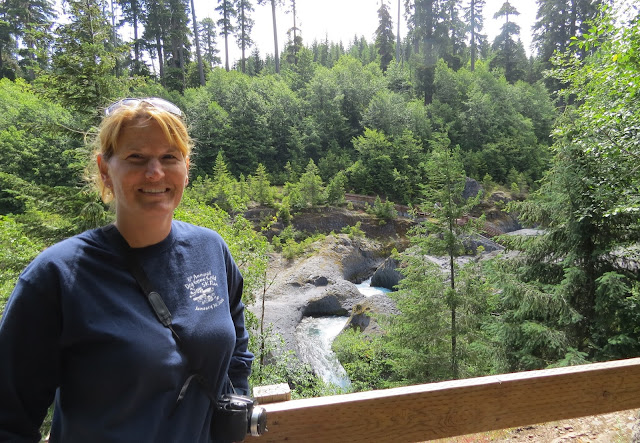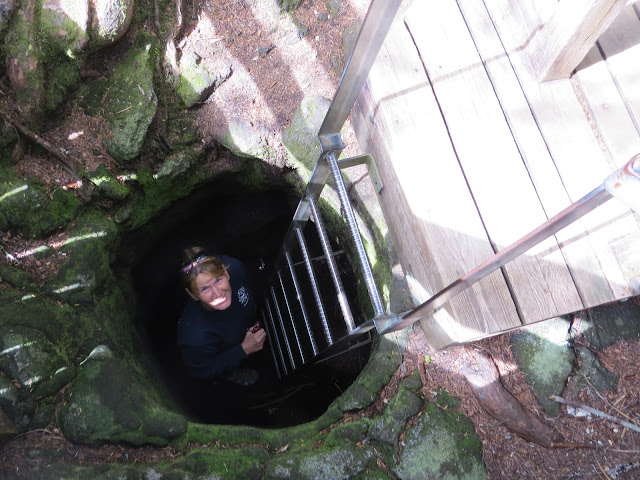My daughter flew in to Portland from her home in Georgia to spend a week traveling with me in Oregon and Washington. What a fun week of hiking and laughing we had! We started right away with a couple hikes near the Willamette River south of Portland.
Then we went to the coast at Fort Stevens State Park, so Jennifer could spend some time walking along the Pacific Coast, her first time seeing it.She recorded the moment in the sand.
We drove south along the coast as far as Cannon Beach and the famous Haystack Rock.
We had a not-so memorable seaside meal at the Wayfarer Restaurant.We were blessed with a spectacular Pacific sunset.
We also toured the historic Fort Stevens which was attacked by the Japanese during World War II.
Swallows were nesting inside.
Baby swallows.
Tillamook Lighthouse sits just off shore north of Cannon. Sea lions bask on the rocks at its base.
At Ecola State Park we hiked a trail to the beach to see the tide pools.Crescent Beach
Sea stars and green anemones.
The tide was coming in.
We saw some elk near the coast.
Ft. Stevens State Park is at the mouth of the Columbia River.
From there we drove to the west side of Mount Saint Helens. This view is from Silver Lake where we camped, about 50 miles away.
We stopped at a Visitor Center on our way to the mountain. They had some hands-on exhibits...View of Toutle Valley which received the brunt of the massive mud flow from the 1980 eruption. There were elk grazing down there.
Three bull elk grazing in Toutle Valley.
We couldn't have asked for nicer weather for viewing the mountain.
At Johnston Ridge Observatory.
Night hawks were zooming around.
We watched the movie and walked the trails observing the devastation and ongoing natural recovery.
The wildflowers were at their peak...gorgeous!
A stop at Coldwater Lake, one of several lakes created by the 1980 eruption.
After 2 nights there, we drove around the south side of the mountain to Windy Ridge on the east side. On the way we stopped at Lava Canyon for a hike.
You can choose your level of hike here...we did all three!Lava Canyon was formed by a previous eruption of Mt. Saint Helens, not the 1980 event, but it was hidden beneath lush forests. The 1980 eruption scoured away the forest and exposed the canyon's rock formations and waterfalls.
Along the "easy" part of the trail.
You can turn around here, or cross the suspension bridge and return by a more difficult trail on the other side. Or you can cross the bridge and continue down the canyon on the most difficult trail.
You know what we did.
View from the suspension bridge.
Much of this trail is very narrow with steep drop-offs on one side. I couldn't take pictures of the worst parts because I was busy watching my feet.
Drop off...
Then there's this ladder to get you deeper into the canyon.
You can see hikers descending the ladder on the left.
Pausing to look at the remains of a huge Douglas Fir downed by the 1980 eruption.
After that hike we made a couple more stops in the same area. This is Ape Cave. A huge lava tube, you can hike a mile through the darkness, but we just went into the entrance and back out.
Inside Ape Cave.
In the Trail of Two Forests you can crawl through smaller lava tubes created when lava surrounded huge trees. The trees eventually rotted away, leaving these tree-shaped holes. Jennifer thought she would do this, but decided it might not be good for her knees. This is the entrance of the lava tube.
This is where she would have come out, had she crawled through it.
We camped free in a Sno-Park at the beginning of the road to Windy Ridge.
It was foggy when we started up the mountain in the morning.
Remains of trees destroyed by the blast of hot gases and ash are still standing or strewn on the hillside.We stopped to see the "Miner's Car" and read about the couple's fate. They had a permit to enter the "blue zone" to conduct business (mining). They were killed by the eruption and the remains of their car is here.
Miners' Car.
We took a short hike to Meta Lake, a small lake that survived the eruption because it was buried under ice and snow at the time of the eruption.
Because the tall Douglas Fir were killed by the blast, smaller Silver Fir and Mountain Hemlock shot up in the new sunlight. Aquatic life survived, and woodpeckers returned to excavate nests in the standing dead trees.
Our next hike was to the shore of Spirit Lake, the only public access to the lake since the eruption. Large trees still float around on its surface.
The trail to Spirit Lake.
Passing some of the blown down trees.
Wildlife: Ground squirrels like these helped push soil up through the ash which allowed new plants and trees to take root.
This area is covered with pumice, created by the blast.
The mud flow dammed the lake which rose over 200 feet quickly after the blast.
Harry Truman, who owned a cabin and lodge on the shore of the lake, refused to evacuate before the eruption. He and his cabin lie buried deep in the lake.
Elk tracks.
At the shoreline.
Jennifer ventured farther than I did.
We finally saw a bit of the top of Mount Saint Helens peeking through the clouds.
Back up at the road, this is another viewpoint showing more of Spirit Lake. The floating trees are at the far right.
And the clouds cleared away by the time we reached Windy Ridge!
We really have been blessed by good weather.
With just two more days to play, we returned to the Columbia River Gorge. We had one night at Viento State Park which was full of people enjoying the water sports available on the river. Kite surfing and sailboarding were the most popular, but I also saw kayakers out there. Not my kind of kayaking...
We did a couple of waterfall hikes in the gorge. This one is to Wahclella Falls.The trail...
Peeking in a small cave.
Wahclella Falls
Then we did another short hike to Latourell Falls.
You can climb up behind the falls if you want to.
We didn't stop at the most famous waterfalls (like Multnomah) because the crowds were too large, and there was no place to park.
Then we drove up to Vista House for this view of the gorge.
Vista House, built in 1916, is celebrating its 100th anniversary. Notice the stained-glass windows.
Inside Vista House.
We camped our last night together at Ainsworth State Park where we saw one more banana slug!
And had one more hike together. It was a great week with lots of fun. I took Jennifer to the airport in the morning, then I checked out and headed back toward eastern Oregon.

















































































